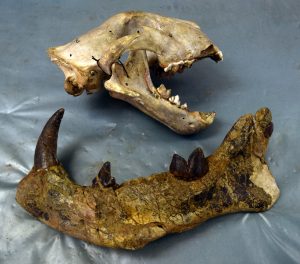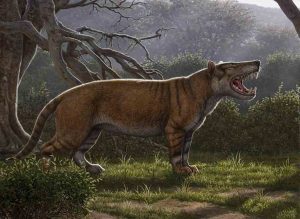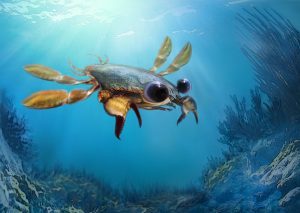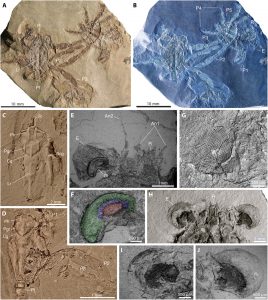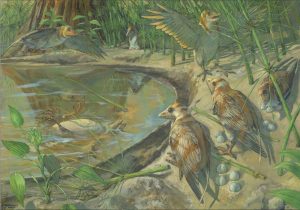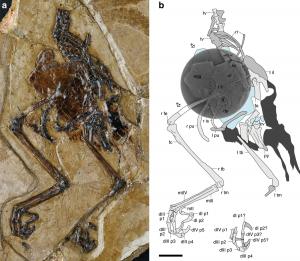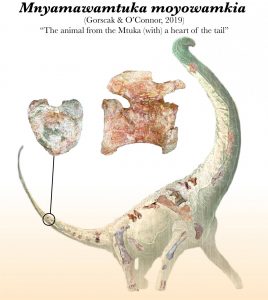The 2019 started with a relatively high number of paleontological discoveries published in highly ranked journals showing that paleontology is sexy indeed! Here you can find a small selection of the most recent ones. The studies in micro- and macropaleontology published earlier this year, provide a large contribution to our understanding of organism evolution and response to peculiar environmental conditions which can be used to predict future ecosystem reactions. Paleontology is therefore not only fascinating but it is a valid instrument for assemble a possible scenario of biotic changes in the future.
A gigantic carnivore from the earliest Miocene of Kenya
A relatively young adult of a gigantic carnivore from the early Miocene (ca. 22 million years ago) was discovered at Meswa Bridge, Kenya. The researchers, Borth M. and Stevens N., called the now extinct carnivore Simbakubwa kutokaafrika, Swahili for “big lion from Africa” since this predator would have played a lion-like role. It is the oldest known member in a group of extinct mammals called hyaenodonts, so named due to their dental resemblance to hyenas, even though the groups are also unrelated. The specimen was known from most of its jaw, portions of its skull and parts of its skeleton. It was larger than a modern polar bear, it weighed up to 1,500 kilograms, measured 2.4 meters long from snout to rump and stood 1.2 m tall at its shoulders.The study was published in the Journal of Vertebrate Paleontology and helps connect some of the evolutionary steps for this group which were near the top of the food chain in theAfrican ecosystems where early apes and monkeys were also evolving. The fossil may also help scientists better understand why these apex predators ultimately did not survive.
A modern lion skull (above) compared to the left part of a Simbakubwa kutokaafrika jaw (below) photographed by Matthew Borths. On the right, a rendering of Simbakubwa kutokaafrika (image credits Mauricio Anton).
Exceptional preservation of mid-Cretaceous marine arthropods and the evolution of novel forms via heterochrony
A new, exceptionally preserved crab from the mid-Cretaceous of Colombia and the United States was discovered by Luque et al. The completeness of the fossil remains shed light on the early disparity of the group and the origins of novel forms.This ancient crab was named Callichimaera perplexa, which means “perplexing beautiful chimera”, and lived during late Cretaceous (ca. 95 to 90 million years ago). The name references the mythical chimera from Greek mythology, which had a lion’s head, a goat’s body and a snake’s tail. The C. perplexa had large unprotected compound eyes, small fusiform body, and leg-like mouthparts suggesting larval trait retention into adulthood via heterochronic development (pedomorphosis), while its large oar-like legs represent the earliest known adaptations in crabs for active swimming. The authors, who published their study in Science Advances, think that these creatures lived in the water, swimming more than crawling around on land (due to the unusual legs) and were active predators.
A rendering of Callichimaera perplexa (Image credits Oksana Vernygora / University of Alberta). On the right dorsal, frontal, and ocular features in Callichimaera perplexa, from the mid-Cretaceous of Colombia (Luque et al. 2019) .
Unlaid egg discovered in an Early Cretaceous bird fossil
A new enantiornithine, Avimaia schweitzerae gen. et sp. nov., from the Lower Cretaceous Xiagou Formation was described by Bailleul et al. The discovery is of great importance since it tetifys the oldest documented case of a common reproductive disorder: called “egg-binding,” where an egg becomes trapped inside a bird. The fossilized bird was in fact found with an unlaid egg two-dimensionally preserved within the abdominothoracic cavity. Ground-sections reveal abnormal eggshell proportions, and multiple eggshell layers best interpreted as a multi-layered egg resulting from prolonged oviductal retention. The find, reported in Nature Communications, belonged to a sparrow-size flyer that lived in northwestern China ca. 110 million years ago. The team has named the bird Avimaia schweitzerae (Avimaia means “mother bird”; and schweitzerae honors paleontologist Mary Schweitzer.)
A rendering of the female individual Avimaia schweitzerae dead in the water on the left (with an unlaid egg not visible inside its abdomen), represents the fossilized individual discovered in China. Illustration by Michael Rothman. In the center and right side, photograph and line drawing of the holotype of Avimaia schweitzerae, IVPP V25371. a Photograph of the partial skeleton with feather impressions, and the crushed preserved egg between the pubes; b interpretive line drawing, with white arrows indicating the two fragments extracted for microscopic analysis with a super-imposed CT-scan revealing the egg and underlying elements of the right pelvis in dorsal (synsacrum) and medial (ilium) view (from Bailleul et al. 2019).
A new African Titanosaurian Sauropod Dinosaur from the middle Cretaceous of Southwestern Tanzania
Paleontologists recently discovered a new titanosaurian sauropod – a giant, plant-eating dinosaur – and named it Mnyamawamtuka moyowamkia. A common component in Cretaceous African faunas, titanosaurian sauropods diversified into one of the most specious groups of dinosaurs worldwide and this discovery is helping paleontologists understanding how, where and when the mightiest of land animals evolved. Mnyamawamtuka moyowamkia lived around 100-110 million years ago, during the middle of the Cretaceous and was found in the Mtuka Member of the Galula Formation (Aptian–Cenomanian) in southwest Tanzania.
Titanosaurs are best known from South America, Tanzania, Egypt, and other parts of the African continent. The new specimen described by Gorscak and O’Connor in PlosOne preserves teeth, elements from all regions of the postcranial axial skeleton, parts of both appendicular girdles, and portions of both limbs including a complete metatarsus. This finding adds a bit more detail to the picture of what ecosystems on continental Africa were like during the Cretaceous.
All these findings make you wonder: ‘what else is out there for us to discover?’

